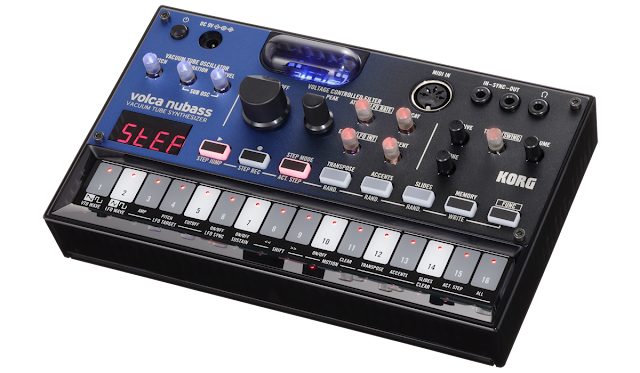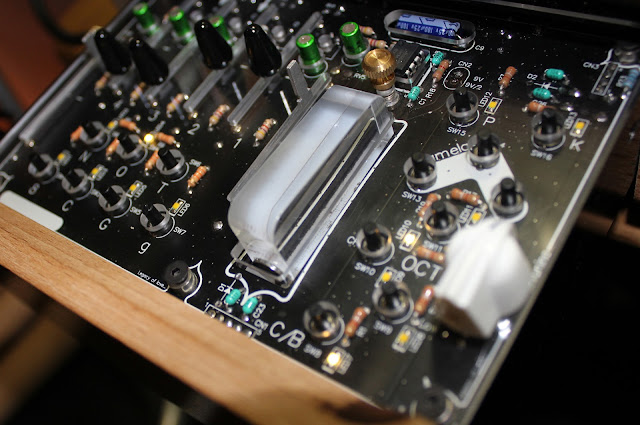Motus – Creative Motion Enhancer from
TZM Creative Lab on
Vimeo.
"Motus allows users to literally play music in the air. No keys, buttons or knobs. While holding Motus in hand, you can play the note and at the same time change its timbre by using different motion gestures."
See
https://motusmotus.com for additional details including their crowdfunding campaign for the Motus.
The following is pulled from
their press release where you'll find additional pics:

"Bow without strings, play synths without pressing the keys. An exciting and simple, yet intelligent wireless musical instrument converts motion gestures to sounds

TZM Creative Lab introduces their first product,
Motus – Creative Motion Enhancer. A wireless device converting motion to sound, a creative tool for professional musicians, dancers and artists, an intelligent toy for kids and grown-ups. Available on crowdfunding campaign now, for less than $100.

Motus is a mobile wireless device that turns motion to sound. In human’s language, it allows users to literally play music in the air. No keys, buttons or knobs. While holding Motus in hand, user can play the note and at the same time change it’s timbre by using different motion gestures. Instead of defining single way to play Motus, we simply offer different interaction rules. While loading a different Motus instrument, you’re redefining what it will be – shaker, air drums, violin or something else. Use each instrument just as you would in reality. Motus technology tracks user’s free movements, extracts the most important motion features (e.g. velocity, dynamics, displacement) and maps them to different sounds. It can be a real-time generated sounds, prerecorded material or even sound and light effects. The size of Motus is optimal for easy handling and excellent control.
Motus technology tracks user’s free movements, extracts the most important motion features and maps them to different sounds.
New possibilities in music
Music
“By developing Motus we are keen to engage more people to explore new possibilities of being creative. It started as a tool that expands musical performance, however later we saw it has very broad use cases, e.g. dance, performing arts, or just having fun for people that have no connection with music at all. Anyone who is willing to experiment with digital sound is hindered by the process. Therefore, we did reverse the whole thing and made it approachable in a simple and exciting way, by using motion as a natural input into digital sound synthesis. The space around you becomes a touchless surface, a canvas you can interact with and explore. Motion with Motus turns the air into a keyboard, fret board, djembe skin, drum pads, violin bow, etc. The movement is a key to play and experiment with sound in real-time whether during casual time outdoors or on stage.” – said Mindaugas Badokas founder of TZM Creative Lab. “Motus is also, in part, about community. We seek to empower motion to open up more possibilities of creativity in sound exploration and gather the whole community which keeps that alive. Where anyone can take part from professional musicians to dancers, from grown-ups to kids (even 30 years-old kids).”
Motion with Motus turns the air into a keyboard, fret board, djembe skin, drum pads, violin bow, etc. The movement is a key to play and experiment with sound in real-time.
Three different Motus versions
Motus Classic is out-of-the-box device and can be explored instantly by anyone. It provides full Motus experience, however it should not be used for professional applications.
Motus Pro is made for professional performers, it comes with an external Bridg receiver and precision sensors, its connectivity rage is up to 30 meters and possibility to connect up to 12 devices simultaneously. It is a perfect fit for using on stage and demanding tasks of any performance.
Motus Hacker is offered for the adventurous DIY enthusiasts seeking to make their own customized device, it comes without usual body and each part has to be soldered together by the user. Depending on added elements it may be used on stage, however this is highly variable, therefore it is not recommended for professional application but more for the experimentalists.
Connectivity
Motus comes together with its software, where users are able to select Motus instruments and play them instantly. It as well can be used as a controller with any DAW of choice—it is compatible with MIDI, OSC and ReWire. Ableton Live users will be provided with M4L device to make the set-up easier. Max users will be offered a pack of externals and abstractions.
In contemporary dance scene for 2 years
Usually dancer follows the music and technicians follows the dancer to implement the image and audible atmosphere of the show. Motus enables dancers to directly control and improvise with sound, live visuals or lighting. Dance troupe Aura has been using Motus prototype for the past three seasons in the play “Make a Switch from me”, which was premiered in Italy, Lithuania and Poland. Composer found Motus being a versatile tool. “Motus helps to communicate message faster and gives an opportunity to expand your fantasy but still keep the audience in it.”, explained Antanas Jasenka, Composer.
Motus not only provided an immersive experience for the audience but as well for the dancers. Francesco Dalmasso, dancer at Aura Dance Theatre said “You have really close connection that you’re actually creating the choreography yourself and at the same time creating the music, sounds, so you’re both – choreographer and composer and a dancer. It’s very rich.”
Dance troupe Aura has been using Motus prototype for the past three seasons in the play “Make a Switch from me”

Coolgarden – the app store for Motus
TZM Creative Lab will be opening a standardized platform, Coolgarden – app store for Motus. Coolgarden is a place where Motus users will be able to find all Motus instruments and creative applications. Therefore, developers are invited to develop Motus instruments and offer them for Motus users through Coolgarden. Developers can offer everything from synths, audio effects, visual generators or interactive games which can be monetized or free for users.
Embedding latest technologies
In the last years scientific approaches to human-computer interfaces and interactions for musical performance gained increasing attention from scholars. Some of the reasons for this are computational speed progress and microcontrollers price drop, which have opened new possibilities in the realm of real-time musical interactions. Motus is an outcome of many experiments and scientific endeavors. We’re bringing cutting edge technologies straight to the user. By doing this we can exit alpha stage faster and implement exciting features found only in scientific papers and research facilities.
Available on crowdfunding
Motus was launched on a self-starter crowdfunding campaign on 21th of October. The company seeks to reach its crowdfunding goal of $28,000 in 30-day period until the 20th of November. During a campaign Motus devices are offered for an introductory price starting from $80. First supporters will be able to purchase a limited number of devices for even more discounted price. The collected funds will be used for securing first batch of production: finalizing the product, setting up manufacturing and future development."

 The acid bass machine with the pinnacle of modulation and distortion.
The acid bass machine with the pinnacle of modulation and distortion. Even today, when digital technology allows electronic musical instruments to simulate any sound imaginable, people seek the warm harmonics and distortion produced by analog vacuum tubes. This distinctive sound has a quality beyond words that sets it apart, and cannot be captured by a response curve; it's the unmistakable sound of tubes.
Even today, when digital technology allows electronic musical instruments to simulate any sound imaginable, people seek the warm harmonics and distortion produced by analog vacuum tubes. This distinctive sound has a quality beyond words that sets it apart, and cannot be captured by a response curve; it's the unmistakable sound of tubes.  The volca nubass is the first analog synth to be equipped with a Nutube new-generation vacuum tube in its oscillator. Vacuum tube plus analog means that the sound is warm, thick, and rich. The familiar transistor ladder filter gives it the character of a classic bass machine, along with overdrive, and huge-sounding distortion.
The volca nubass is the first analog synth to be equipped with a Nutube new-generation vacuum tube in its oscillator. Vacuum tube plus analog means that the sound is warm, thick, and rich. The familiar transistor ladder filter gives it the character of a classic bass machine, along with overdrive, and huge-sounding distortion. 






























































